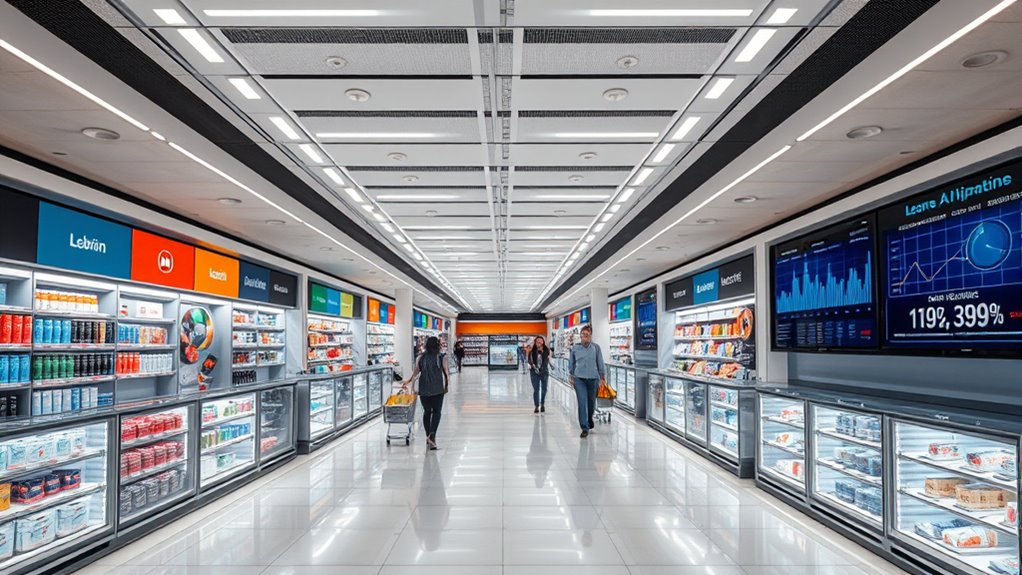AI for optimizing retail store layouts uses sensors and cameras to analyze customer movement, creating heatmaps that show traffic patterns. It helps you place products strategically to boost visibility and sales. With adaptive layouts, you can customize experiences for different shopper groups and adjust in real time based on traffic shifts. By leveraging predictive analytics, you’ll plan layouts that maximize revenue. Keep exploring to discover how these innovations can transform your retail space.
Key Takeaways
- AI uses sensors and cameras to analyze customer movement and create heatmaps for better store layout decisions.
- Personalized layouts are developed by segmenting shoppers and customizing displays for different demographics.
- Real-time data allows dynamic adjustments to store layouts based on seasonal trends, events, and traffic shifts.
- Predictive analytics forecast optimal configurations, enhancing product placement and overall store performance.
- AI-driven strategies can boost sales by up to 540% through optimized space utilization and improved customer engagement.

In today’s competitive retail landscape, optimizing store layouts is vital for attracting customers and boosting sales. AI techniques have revolutionized how you approach this task. By analyzing customer movement patterns through sensors and cameras, AI creates heatmaps that clearly show high and low traffic zones within your store. This insight allows you to position products where they’re most likely to catch shoppers’ attention, increasing the chances of impulse buys. Using AI-powered product placement tools, you can determine the best spots for your merchandise, guaranteeing the most visible items get the spotlight. This targeted approach not only improves product visibility but also encourages quicker decisions, leading to higher sales.
Optimizing store layouts with AI boosts visibility, drives impulse purchases, and increases sales through data-driven product placement.
AI doesn’t just work on a static level; it adapts to changing conditions. By segmenting your customer base based on demographics and preferences, AI enables you to customize layouts for different shopper groups. For example, younger customers might respond better to interactive displays or digital signage, while older shoppers may prefer straightforward navigation. These personalized layouts improve customer satisfaction and make shopping more engaging. Additionally, AI makes it possible to adjust your store layout in real-time. If foot traffic shifts due to seasonal trends, special events, or daily fluctuations, AI can recommend and implement immediate changes to optimize flow and product placement. This agility ensures your store remains efficient and inviting, no matter the circumstances.
Predictive analytics play an essential role in layout optimization. AI models analyze historical data—such as sales figures, foot traffic, and online interactions—to forecast which configurations will perform best. This proactive approach helps you plan store layouts that maximize sales and operational efficiency. For instance, AI might identify certain categories as key drivers of revenue and suggest placing these in high-traffic areas for maximum exposure. The result is a store that’s strategically arranged to capitalize on customer behaviors and preferences.
The benefits of this AI-driven approach are significant. Well-optimized layouts can boost sales by up to 540%, according to some studies. They also lead to higher conversion rates and increased average transaction values. Besides improving sales, AI-enhanced layouts give you a competitive edge by making better use of your retail space and creating a seamless shopping experience. Customers enjoy easier navigation and personalized shopping journeys, which increases engagement and satisfaction. This, in turn, encourages repeat visits and strengthens loyalty. Ultimately, AI not only helps you understand your customers better but also empowers you to design store environments that are both profitable and enjoyable for shoppers.
Frequently Asked Questions
How Does AI Adapt to Changing Customer Preferences?
You want to know how AI adapts to changing customer preferences. It does this by continuously analyzing purchase data, online browsing habits, and in-store movements to spot evolving trends. AI then adjusts store layouts in real-time, repositioning products and optimizing pathways. This dynamic approach guarantees your store stays relevant, improves customer experience, and boosts sales by responding quickly to shifting shopper behaviors and preferences.
What Are the Costs Associated With Implementing AI Layout Optimization?
Is investing in new technology worth it? Implementing AI layout optimization involves upfront costs like software licenses, hardware, and data infrastructure. You’ll also spend on staff training, change management, and ongoing maintenance, licensing, and scalability. Are you ready to handle the recurring expenses and continuous updates? While the initial investment can be significant, the potential for improved customer experience and increased sales makes it a strategic choice worth considering.
Can AI Integrate With Existing Retail Management Systems?
You’re wondering if AI can work with your current retail management systems. The good news is, AI can often be seamlessly integrated with systems like CRM, ERP, and POS. It synthesizes data from various sources, improving decision-making and operational efficiency. As long as your systems are compatible and you have the right infrastructure, AI can scale and adapt to your needs, making your store smarter and more efficient.
How Secure Is Customer Data Used for AI Analysis?
Your customer data’s security is absolutely crucial—it’s the backbone of trustworthy AI analysis. With advanced encryption, strict access controls, and regular security audits, your data stays protected from even the most sophisticated threats. By following industry standards and complying with regulations like GDPR and CCPA, you guarantee customer trust remains unbreakable. Rest assured, your data security measures are designed to keep customer information safer than you ever imagined.
What Are the Limitations of AI in Retail Layout Planning?
You should know that AI faces several limitations in retail layout planning. It struggles with data quality, integration, and privacy concerns, which can compromise accuracy. Technical challenges like high costs, need for expertise, and system compatibility also pose issues. Additionally, physical space constraints, seasonal changes, and customer preferences may limit AI’s effectiveness. Relying too heavily on AI might overlook valuable human insights and customer feedback, impacting overall success.
Conclusion
By leveraging AI to optimize retail store layouts, you can boost sales and enhance customer experience. Studies show that well-designed layouts can increase sales by up to 40%. Imagine guiding customers effortlessly through your store and encouraging more purchases—AI makes that possible. With data-driven insights, you can create a shopping environment that’s both inviting and efficient. Embrace AI today, and watch your store thrive as customers enjoy a seamless, personalized shopping journey.











